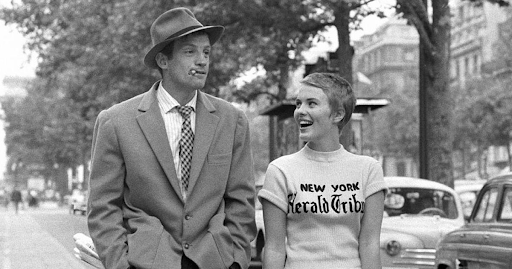Does French New Wave Classic Breathless Still Hold Up?

Photo Courtesy of Scroll.In
By Dean Robbins
It is hard to fully understand the impact of director Jean-Luc Godard’s 1960 debut feature Breathless today. Essays and books have been written on the film, such as the Rutgers Films in Print book that includes the film’s script and a series of essays from noted film critics and historians. Whole artistic movements have been inspired by Breathless. The liberal usage of jump cuts and the free-flowing rhythm that resulted from a rebellious production was shockingly novel in a time where rigid studio systems dominated mainstream cinema. Yet in a time where many of its innovations are taken for granted, is Breathless still worth watching for reasons besides its historic status?
Jean-Paul Belmondo plays Michel Poiccard, a slimy, womanizing criminal who robs and murders to maintain a mirage of wealth and respectability. He finds his match in American journalist Patricia Franchini, played by Jean Seberg. Along the way, Poiccard evades detectives and seduces Franchini, who may be more in on the grift than she lets on.
Godard was inspired by the popular noir films of the forties and fifties, such as Gun Crazy (1950) and Whirlpool (1949). The latter of those films is actually heard in the background in one scene. A note at the beginning dedicates the film to Monogram Pictures, a poverty row (meaning low-budget, non-major) studio that specialized in light comedies and pulpy crime dramas in the forties. Godard knew these films well through his background as a film critic for the legendary publication Cahiers du Cinema. Godard and his colleagues, many of which would also become filmmakers, would often advocate for films and actors other critics would skewer. That is how Seberg ended up in the female lead role.
Jean Seberg was a small-town American girl from Marshalltown, Iowa with dreams of being a Hollywood star. Director Otto Preminger, best known for classics like Anatomy of a Murder (1959), was auditioning young women across the country for the lead part in his film Saint Joan (1957). Out of thousands of actresses, Seberg won. While it made her into a worldwide sensation, the opportunity would ultimately turn out to be less beneficial. The film was disliked by critics and Seberg’s performance was reviled. After another film with Preminger, it looked like Seberg would begin to quickly fade back into obscurity. Luckily, there were a few critics that liked her performance in Saint Joan: the writers at Cahiers du Cinema. Godard listed Saint Joan as his tenth favorite film of that year and Seberg’s follow-up with Preminger Bonjour Tristesse first as his favorite the following year.
Godard was able to obtain funding to make a film of his own after the success of his colleague Francois Truffaut’s The 400 Blows, who is co-credited with the story of Breathless alongside another New Wave filmmaker, Claude Chabrol. Seberg was a must-have for the part of Patricia and about a third of the budget was spent just on her; however, production was not all smooth sailing.
With a desire to create something fresh and original, Godard bucked many conventions of filmmaking. For instance, Breathless had no full script going into production. Godard would write the day’s scenes in a secret journal over breakfast and then shoot them. On some days, production would last for twelve hours while other days would only last for twenty minutes. Seberg and the crew thought it was going to be a disaster…and it almost was.
When the time came to edit the film, Godard and editor Cecile Decugis found it to be long and boring. Out of ideas, Godard decided to cut within scenes, creating continuity-breaking cuts called jump cuts. While an accident, these cuts would make Breathless immensely influential. These cuts lent a unique rhythm to the story, making conversations jumpy and the pace quick. It also communicated the flow of time viscerally. The cuts often have the effect of breaking immersion as opposed to facilitating it–a cardinal sin of filmmaking. Between an unconventional production and a new editing style, Breathless had broken the rules and it had broken them for good.
Breathless, alongside The 400 Blows, ushered in the “French New Wave.” These films were revolutionary, both in their technique and oftentimes their narratives and politics. Over the next decade, “new wave” movements would spread across the globe. There was a Czechoslovak New Wave, an Indian New Wave (which developed parallel with the French), an American New Wave referred to as New Hollywood, and several more. Films such as Night of the Living Dead, Bonnie and Clyde, and The Graduate were examples of New Hollywood and they have filmmakers like Godard to thank. The envelope was pushed by the French and then again and again across the world.
Breathless is influential and original. All that aside, is it watchable for modern audiences? Yes! The story is admittedly loose, but the two leads give truly iconic performances. The dialogue is often funny. And most of all, it will ruin jump cuts for you! Ever since I saw Breathless, I always think of the film when I see a noticeable jump cut. I think about it a lot! Breathless is now streaming on HBO Max and the Criterion Channel.







